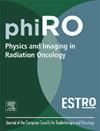利用视觉生物反馈对不同的四维磁共振成像序列进行放射治疗指导的体内比较
IF 3.3
Q2 ONCOLOGY
引用次数: 0
摘要
背景与目的:控制呼吸运动是腹胸区有效放疗的必要条件。呼吸相关四维磁共振成像(4D-MRI)可以提供准确的运动估计,以帮助确定适应性放疗的治疗量。然而,由于存在呼吸变异性,在体内验证和比较4D-MRI序列具有挑战性。本研究将视觉生物反馈(VBF)与4D-MRI序列相结合,以促进体内比较。材料和方法:在两个机构的1.5 T Unity磁共振直线加速器(Elekta AB, Stockholm, Sweden)上对14名健康志愿者和1名患者进行扫描。获得了径向星团(SoS)、同时多层(SMS)和螺旋有序笛卡尔采集(CASPR) 4D-MRI序列。这些采集是在无VBF和有VBF的情况下进行的,基于交错一维呼吸导航(1D-RNAV)采集。使用1d - rnav衍生的呼吸波形来量化不同序列的呼吸变异性。重建的4D-MRI数据用于提取运动幅度,并将其与志愿者内部序列和呼吸波形的幅度进行比较。结果:呼吸变异性在不同序列间分别下降了37%(幅度,p = 0.039)和64%(周期,p <;0.003),在VBF引导下,志愿者内部4d - mri得出的运动幅度一致性中位数从3.5 mm提高到1.8 mm (p = 0.064)。四维mri衍生振幅小于呼吸波形振幅,中位数差异为-31% (SoS), -17% (SMS)和-9% (CASPR)。平均呼吸波形幅度比指示大8%。结论:该方法能够在体内比较适应放疗的4D-MRI序列,并在指导下提高解剖一致性,确保更可靠的比较。本文章由计算机程序翻译,如有差异,请以英文原文为准。
Enabling in vivo comparisons of different four-dimensional magnetic resonance imaging sequences for radiotherapy guidance using visual biofeedback
Background and Purpose:
Managing respiratory motion is essential for effective radiotherapy in the abdominothoracic regions. Respiratory-correlated four-dimensional magnetic resonance imaging (4D-MRI) can provide accurate motion estimation to help define treatment volumes for adaptive radiotherapy. However, validating and comparing 4D-MRI sequences in vivo is challenging due to the presence of breathing variability. This study combines visual biofeedback (VBF) with 4D-MRI sequences to facilitate in vivo comparisons.
Materials and Methods:
Fourteen healthy volunteers and one patient were scanned on a 1.5 T Unity MR-linear accelerator (Elekta AB, Stockholm, Sweden) at two institutions. A radial stack-of-stars (SoS), a simultaneous multi-slice (SMS), and a Cartesian acquisition with spiral ordering (CASPR) 4D-MRI sequence were acquired. These acquisitions were performed without and with VBF based on an interleaved one-dimensional respiratory navigator (1D-RNAV) acquisition. Breathing variability across sequences was quantified using 1D-RNAV-derived breathing waveforms. Reconstructed 4D-MRI data were used to extract the motion amplitude, which was compared intra-volunteer across sequences and to the amplitudes of the breathing waveforms.
Results:
Breathing variability across sequences decreased by 37% (amplitude, p 0.039) and 64% (period, p 0.003), and the median intra-volunteer 4D-MRI-derived motion amplitude agreement improved from 3.5 mm to 1.8 mm (p 0.064) across sequences due to VBF guidance. Four-dimensional MRI-derived amplitudes were smaller than breathing waveform amplitudes, with median differences of -31% (SoS), -17% (SMS), and -9% (CASPR). The average breathing waveform amplitude was 8% larger than instructed.
Conclusions:
This methodology enables in vivo comparisons of 4D-MRI sequences for adaptive radiotherapy, with guidance improving anatomical consistency and ensuring more reliable comparisons.
求助全文
通过发布文献求助,成功后即可免费获取论文全文。
去求助
来源期刊

Physics and Imaging in Radiation Oncology
Physics and Astronomy-Radiation
CiteScore
5.30
自引率
18.90%
发文量
93
审稿时长
6 weeks
 求助内容:
求助内容: 应助结果提醒方式:
应助结果提醒方式:


